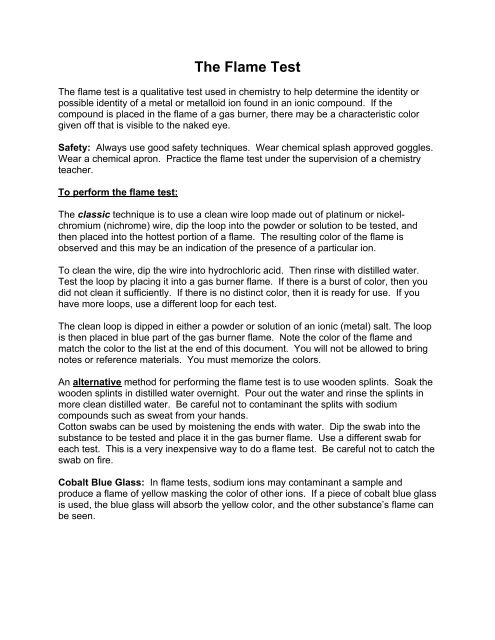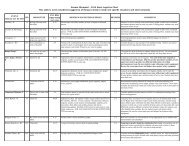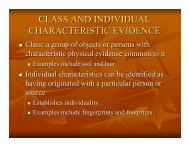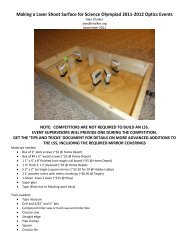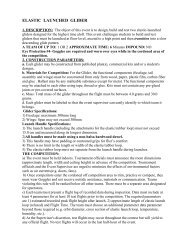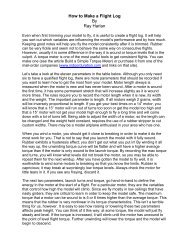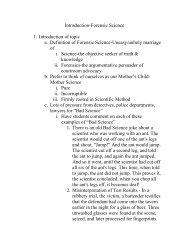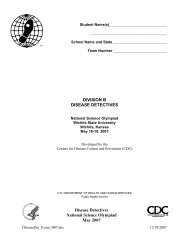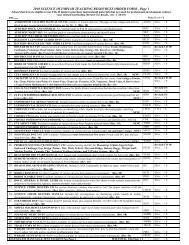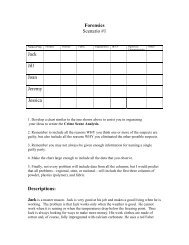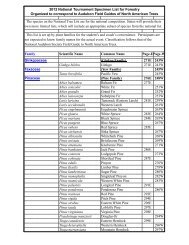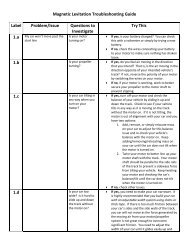You also want an ePaper? Increase the reach of your titles
YUMPU automatically turns print PDFs into web optimized ePapers that Google loves.
<strong>The</strong> <strong>Flame</strong> <strong>Test</strong><br />
<strong>The</strong> flame test is a qualitative test used in chemistry to help determine the identity or<br />
possible identity of a metal or metalloid ion found in an ionic compound. If the<br />
compound is placed in the flame of a gas burner, there may be a characteristic color<br />
given off that is visible to the naked eye.<br />
Safety: Always use good safety techniques. Wear chemical splash approved goggles.<br />
Wear a chemical apron. Practice the flame test under the supervision of a chemistry<br />
teacher.<br />
To perform the flame test:<br />
<strong>The</strong> classic technique is to use a clean wire loop made out of platinum or nickelchromium<br />
(nichrome) wire, dip the loop into the powder or solution to be tested, and<br />
then placed into the hottest portion of a flame. <strong>The</strong> resulting color of the flame is<br />
observed and this may be an indication of the presence of a particular ion.<br />
To clean the wire, dip the wire into hydrochloric acid. <strong>The</strong>n rinse with distilled water.<br />
<strong>Test</strong> the loop by placing it into a gas burner flame. If there is a burst of color, then you<br />
did not clean it sufficiently. If there is no distinct color, then it is ready for use. If you<br />
have more loops, use a different loop for each test.<br />
<strong>The</strong> clean loop is dipped in either a powder or solution of an ionic (metal) salt. <strong>The</strong> loop<br />
is then placed in blue part of the gas burner flame. Note the color of the flame and<br />
match the color to the list at the end of this document. You will not be allowed to bring<br />
notes or reference materials. You must memorize the colors.<br />
An alternative method for performing the flame test is to use wooden splints. Soak the<br />
wooden splints in distilled water overnight. Pour out the water and rinse the splints in<br />
more clean distilled water. Be careful not to contaminant the splits with sodium<br />
compounds such as sweat from your hands.<br />
Cotton swabs can be used by moistening the ends with water. Dip the swab into the<br />
substance to be tested and place it in the gas burner flame. Use a different swab for<br />
each test. This is a very inexpensive way to do a flame test. Be careful not to catch the<br />
swab on fire.<br />
Cobalt Blue Glass: In flame tests, sodium ions may contaminant a sample and<br />
produce a flame of yellow masking the color of other ions. If a piece of cobalt blue glass<br />
is used, the blue glass will absorb the yellow color, and the other substance’s flame can<br />
be seen.
What is the flame test?<br />
<strong>The</strong> flame test is used to visually determine the identity of an unknown metal of an ionic<br />
salt based on the characteristic color the salt turns the flame of a bunsen burner. <strong>The</strong><br />
substances in the competition are: Sodium acetate, sodium chloride, sodium hydrogen<br />
carbonate, sodium carbonate, lithium chloride, potassium chloride, calcium nitrate,<br />
calcium sulfate, calcium carbonate, boric acid, and ammonium chloride. Cornstarch,<br />
glucose, sucrose, magnesium sulfate will give a negative flame test.<br />
Color<br />
Red<br />
Metal Ion<br />
Carmine: Lithium compounds. Masked by sodium.<br />
Yellow-Red: Calcium compounds.<br />
Yellow Sodium compounds, even in trace amounts<br />
Green<br />
Violet<br />
Blue-Green: Boric acid.<br />
Faint Green: NH 4 compounds.<br />
Potassium compounds - Masked by sodium or lithium.<br />
Purple-Red: Potassium in the presence of sodium when viewed through cobalt<br />
blue glass.<br />
Lange's Handbook of Chemistry, 8th Edition, Handbook Publishers Inc., 1952.<br />
Flinn Scientific Inc, Manual 2004.


